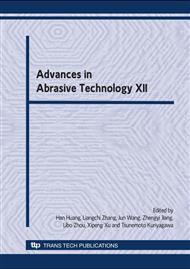[1]
Klocke, F., König, W.: Fertigungsverfahren Band 2 - Schleifen, Honen, Läppen, 4. Auflage, Springer-Verlag, (2005).
Google Scholar
[2]
Tawakoli, T.: High Efficiency Deep Grinding, Technology, process, planning and application, Mechanical Engineering Publication, London, (1993).
Google Scholar
[3]
Werner, G., Tawakoli, T.: Fortschritte beim HEDG-Verfahren mit CBN-Schleifscheiben, Industrial Diamond Review, IDR 1 (1990).
Google Scholar
[4]
Schulz, A.: Das Abrichten von keramisch gebundenen CBN-Schleifscheiben mit Formrollen, Dr. -Ing. Dissertation, RWTH Aachen, (1996).
Google Scholar
[5]
Tawakoli, T., Westkämper, E., Rasifard, A.: Prozessorientiertes Abrichten mit Formrollen, wt Werkstattstechnik online 96 (2006), Nr. 6, S. 359-365, ISSN: 1436-4980.
DOI: 10.37544/1436-4980-2006-6-359
Google Scholar
[6]
Tawakoli, T.; Rabiey, M., Rasifard, A.: The new developments in CBN grinding technology, 1st International Industrial Diamond Conference, 20-21 October 2005, Barcelona, Spain, Proceedings CD.
Google Scholar
[7]
Tawakoli, T., Westkämper, E., Rabiey, M., Rasifard, A.: Int. J. Mach. Tools Manuf. Vol. 47 ( 2007), p.729.
Google Scholar
[8]
Tawakoli, T.; Westkämper, E.; Rabiey, M.; Rasifard, A.: A Systematic Study to Compare Oil with Emulsion for CBN Grinding Tools, The 38th CIRP, International Seminar of Manufacturing Systems, May 16, 2005, Florianopolis, Brazilian, Proceedings CD.
DOI: 10.1016/j.ijmachtools.2006.09.010
Google Scholar
[9]
Institute Fraunhofer IVV: Mineralölfreier Schmierstoff auf Polymerbasis zur Kostensenkung und Ressourcenschonung in Prozessen der spanenden Fertigung und der Oberflächenbehandlung, http: /www. ivv. fraunhofer. de.
DOI: 10.17147/asu-1-204744
Google Scholar
[10]
Lippok, C.: Außenrund-Feinschleifen mit keramisch gebundenen CBN-Schleifscheiben, Dr. -Ing. Dissertation, RWTH Aachen, Shaker Verlag, (1997).
Google Scholar
[11]
Linke, B; Maier, B.; Klocke, F; Zeppenfeld, C.: Tribologisches Einsatzverhalten von cBN beim Schleifen mit unterschiedlichen Kühlschmierstoffen, Diamond Business, 3/(2007).
Google Scholar
[12]
Beyer, P.: Hochproduktives Schleifen mit keramisch gebundenen Superabrasives, Teil 1: Die HPB-Technologie für Vit-CBN-Schleifwerkzeuge, IDR, Ausgabe 4/(2004).
Google Scholar
[13]
Blankenburg, S.; Stabenow, R.; Göhler, V.: Nutzung des Zerspanungspotenzials mit keramisch gebundenen Schleifscheiben, Diamond Business, 2/(2007).
Google Scholar


